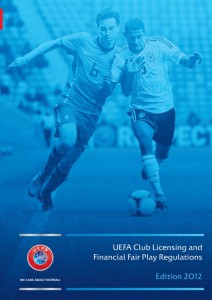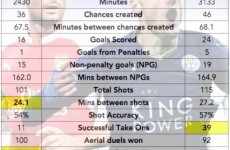.
ANDREW NIXON is a sports lawyer, a partner in the sports group at Sheridans. He is a specialist in the regulatory framework of football and has advised clubs and individual players on regulatory disputes. In the first of a series of new columns for Sportingintelligence, Nixon explores whether a challenge to Uefa’s FFP regulations by a Belgian agent, Daniel Striani, could scupper the European body’s plans.
13 May 2013
In 1995 the case of Jean-Marc Bosman came before the European Court of Justice and changed the face of football in Europe. The case involved (amongst other issues) a challenge to the legality of the transfer system for football players.
The ECJ found in favour of Bosman and against his club, RFC Liege, the Belgium FA and UEFA, determining that transfer fees for out-of-contract players were illegal where a player was moving between one EU nation and another.
Almost 18 years later, a Belgian football agent, Daniel Striani, has lodged a complaint with the European Commission on the basis that UEFA’s Financial Fair Play Regulations are anti-competitive and will negatively impact on his ability to generate income. It is a challenge that may yet have an impact as significant as that of Bosman.
Background to the Financial Fair Play Rules
The spending of football clubs, particularly those licensed by and under the jurisdiction of UEFA has long been an issue and a point of debate within the sport. In England, whilst commercial revenues have continued to rise (the Premier League sold the domestic broadcast rights alone for seasons 2013-2016 for £3.018bn), that has not necessarily reflected itself on the balance sheet, with many clubs having experienced falling operating profits and pre-tax losses.
Some clubs have been able to operate as normal, and indeed expand squads and wage bills, as losses were underwritten by wealthy investors and benefactors. Other clubs have operated at levels above their means, gambling player wages against receipt of broadcasting revenue, a strategy which has on more than one occasion led to insolvency events involving high profile clubs.
In September 2009 the first steps were taken to positively address the spiralling debt within European football when UEFA’s Executive Committee approved the concept of financial fair play. The objectives were as follows:
- to protect the long term viability of European club football;
- to introduce more discipline and rationality into club finances;
- to decrease pressure on salaries and transfer fees and limit inflationary effects;
- to encourage clubs to compete within their means;
- to encourage long-term investments in academies and youth infrastructure; and
- to ensure clubs settle liabilities on a timely basis.
The overriding obligation on clubs licensed by UEFA is, over a period of time, to balance their books, or break even. Under the rules, clubs cannot repeatedly, as part of a multi-year assessment, spend more than their generated income, thereby enabling a longer term view to be formed.
The UEFA Executive Committee approved the creation of a Club Financial Control Body in June 2012 (replacing the Club Financial Control Panel) which oversees the application of the Financial Fair Play Regulations alongside the Club Licensing System and is competent to impose disciplinary measures.
Clubs have had their accounts monitored since summer 2011, with the break even assessment covering financial years ending 2012 and 2013, to be assessed during the 2013-14 season.
The principles behind FFP were also adopted domestically in England, initially by the Football League which has had to deal within a number of insolvency events and administrations. In the Championship, clubs have agreed to introduce a break even approach based on the UEFA FFP model, whilst in League 1 and League 2 clubs will implement the Salary Costs Management Protocol which (broadly) limits spending on total player wages to a proportion of each club’s turnover.
Just last month, the Premier League ratified its own financial fair play regulations which, amongst other elements, will mean that clubs with a total wage bill of more than £52m will only be allowed to increase the wage bill by £4m per season for the next 3 seasons (restrictions applying to broadcasting income only).
The Striani Challenge
The overall objectives of FFP are, on the face of it, in the interests of the game and its future as a self sustaining sport. Indeed, the licensee clubs themselves agreed to the implementation of the rules. Why therefore has Striani launched this challenge?
There are real issues of sporting regulation that will need to be addressed and analysed by the Commission. The key arguments that Striani will employ will be that the break even rule (article 57 of the UEFA Financial Fair Play Regulations):
– Will restrict outside investment in football clubs;
– Effectively preserves the dominance of clubs that do not operate losses by preventing clubs operating at losses in order to break through;
[NB: I wonder if the point here is that it preserves the dominance of clubs that have previously operated at a loss, eg, Chelsea and Man City), by preventing other clubs from doing the same?]
– Will dampen the transfer market and salary levels, with a knock on effect on Striani’s ability to generate revenue and income.
Is it a complaint with merit?
The reality is that the competition rules of the EC Treaty were drafted with more orthodox industries in mind than sport and perhaps the key document when assessing the Commission’s attitude to sporting rules is its 2007 White Paper on Sport (PDF linked here), which addresses, amongst other matters within sport, governance and licensing.
Indeed, at paragraph 4.7 of the White Paper the Commission acknowledges the usefulness of robust licensing systems for clubs as a ‘tool for promoting good governance in sport’.
The Commission stated that these licensing systems generally aim to ensure that all clubs respect the same basic rules on financial management and transparency. However, such systems must be compatible with competition laws and the Internal Market provisions and must have at their heart a legitimate aim and objective.
There are a number of industry nuances which are recognised and will be applied when assessing compliance with Community law. For example, sport must involve uncertainty of outcome and there must therefore be a degree of competitive balance and equality within competitions, which of course sets it aside from other industries in which, unlike sport, there is no interest in competitors retaining economic stability.
However, despite these accepted nuances, the Commission will not reject the complaint simply because FFP purports to maintain competitive balance (indeed, one of Striani’s key arguments is that it does the exact opposite) as the ECJ has long since rejected the ’sporting exception’ argument on the basis that, as determined in an anti-doping case, – the Meca-Medina & Macjen v the Commission Case 519/04, ECR 2006 1-6991 – sporting rules do not fall outside the scope of EC Competition Law simply because they regulate sport.
The ECJ in Meca-Medina ruled unreservedly that although the doping ban was proportionate in the circumstances, and doping rules were a legitimate means of protecting sporting integrity, all sporting regulations which produced appreciable economic effects must be subject to review.
The objective of the anti-doping rules was to ensure fair competition, and a level playing field for all and were ‘inherent in the organisation and proper conduct of competitive sport’; however, will the Commission (and if necessary the General Court and the ECJ) view FFP in the same light?
The Commission has produced a methodology as to how it will apply competition law to sport.
The first question to be considered is whether or not the body that adopted the rule is an undertaking, or an association of undertakings.
The second question will be whether or not the FFP regulations (specifically the break even rule) restricts competition, or indeed constitutes an abuse of a dominant position, and in answering this question the Commission will give consideration to the overall context of the rules, whether or not the rules are inherent in the pursuit of the body’s objectives and whether or not, in light of the overall objective, the rule is proportionate.
Thirdly and fourthly, the Commission will consider if the rule affects member state trade and if the rule fulfils the conditions of Article 101(3) EC.
What broad conclusions can be reached by applying this methodology to FFP?
Is UEFA an undertaking? An undertaking is described as an entity engaged in economic activity and there is no doubt that UEFA, and its member clubs, are undertakings within the meaning of 101 and 102 EC. Indeed, UEFA would be considered to be an association of undertakings.
Do the FFP rules restrict competition or constitute an abuse of a dominant position? Rules drawn up by a sports governing body will constitute a decision by an undertaking, or an association of undertakings. Therefore, on that basis, those rules may have the effect of distorting competition, even if the objectives are not such and there is merit in any argument that FFP has a distortion effect.
Do the FFP rules pursue a legitimate objective (the impact of which is proportionate to that objective)? The ruling in Meca-Medina discounts any reliance on the sporting exception argument. However, legitimate objectives will relate to organisation and proper conduct of competitive sport and, arguably, FFP complies with this requirement in that its objective is to safeguard the financial stability of the sport. However, the Commission will need to analyse whether or not FFP goes further than is reasonably necessary to secure the objective of financial stability.
Will FFP affect inter-Community trade? The answer to this question will almost certainly be yes and it is generally accepted that rules adopted by international sports governing bodies will affect trade when an economic activity is involved. In this case, FFP will inevitably have an impact on the transfer market and player trading between member states.
Is the restriction justified? It will be, but only if the beneficial effects of the rule outweigh its restrictive effects, and there is merit in any argument that it does not. The purpose of the break even rule is to ensure that clubs spend within certain limits, thereby ensuring they do not overstretch themselves financially.
From a competition perspective, this will inevitably dampen the player transfer market, which will have a knock-on effect on the ability of agents such as Striani to generate income. The rule will also prevent investment in clubs by third parties which will arguably preserve the dominance of certain clubs, as opposed to making the competition fairer and more balanced. That reduced investment will also have a direct impact on playing squads, both in terms of the level of player remuneration and the size of those playing squads.
The Commission responded positively to complaints raised with it in relation to the FIFA Player-Agent Regulations in the late 90s, eventually issuing a statement of objections in which it asserted that the FIFA Player-Agent Regulations contravened then article 81(1) of the Treaty by limiting access to the player-agent market. Notably, the Commission took the view that the objectives of the regulations could be achieved by less restrictive means, stating that:
“The Rules prevent or restrict natural or legal persons with the necessary vocational skills from having access to a job. The Commission recognises that there must be checks on access to the profession and that some rules are necessary in order to ensure the smooth operation and to prevent deterioration in the ethical values in sport. However, the rules must be in proportion to the objective pursued. There are clearly other rules which could ensure professionalism on the part of agents without being unduly restrictive.”
A key question will therefore be: are there other feasible rules which could ensure financial fair play in European football, which meet the objectives, but are less restrictive? Arguably, these less restrictive, objective meeting rules are already in force. It has always been the case that clubs are required to demonstrate, as part of the licensing criteria, that there are no overdue payables to other clubs, their employees, or to tax authorities.
Indeed, it will also inevitably be argued by Striani that there are other, better means of redressing competitive imbalance, such as a restructuring of the revenue sharing mechanism between clubs, with perhaps the adoption of a form of ‘tax’ on the higher spending clubs.
It is the writer’s view that employing a regulatory system of financial control is a justified means of ensuring that football clubs compete within their own commercial boundaries and the objective of FFP is therefore credible and justifiable.
However, it is entirely possible that the challenge will find its way to the CJEU and it will not necessarily be a comfortable ride for UEFA. Whether or not Striani can take his place alongside the likes of Bosman and Meca-Medina remains to be seen and will be watched with interest.
Andrew Nixon is a partner in the sports group at Sheridans. He is a specialist in the regulatory framework of football and has advised clubs and individual players on regulatory disputes. On Twitter, follow Andy Nixon and Sheridans











